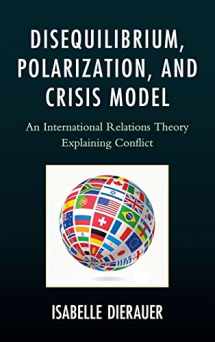
Disequilibrium, Polarization, and Crisis Model: An International Relations Theory Explaining Conflict
ISBN-13:
9780761861058
ISBN-10:
076186105X
Edition:
1
Author:
Isabelle Dierauer
Publication date:
2013
Publisher:
University Press of America
Format:
Hardcover
280 pages
FREE US shipping
on ALL non-marketplace orders
Rent
35 days
Due Jun 13, 2024
35 days
from $37.01
USD
Marketplace
from $34.29
USD
Marketplace offers
Seller
Condition
Note
Seller
Condition
Used - Good
Book details
ISBN-13:
9780761861058
ISBN-10:
076186105X
Edition:
1
Author:
Isabelle Dierauer
Publication date:
2013
Publisher:
University Press of America
Format:
Hardcover
280 pages
Summary
Disequilibrium, Polarization, and Crisis Model: An International Relations Theory Explaining Conflict (ISBN-13: 9780761861058 and ISBN-10: 076186105X), written by authors
Isabelle Dierauer, was published by University Press of America in 2013.
With an overall rating of 3.6 stars, it's a notable title among other
Civil War
(United States History, World War I, Military History, International & World Politics, Politics & Government, Americas History) books. You can easily purchase or rent Disequilibrium, Polarization, and Crisis Model: An International Relations Theory Explaining Conflict (Hardcover) from BooksRun,
along with many other new and used
Civil War
books
and textbooks.
And, if you're looking to sell your copy, our current buyback offer is $0.3.
Description
Different international relations theorists have studied political change, but all fall short of sufficiently integrating human reactions, feelings, and responses to change in their theories. This book adds a social psychological component to the analysis of why nations, politically organized groups, or states enter into armed conflict. The Disequilibrium, Polarization, and Crisis Model is introduced, which draws from prospect theory, realism, liberalism, and constructivism. The theory considers how humans react and respond to change in their social, political, and economic environment. Three case studies, the U.S. Civil War, the Yugoslav Wars (1991-1995), and the First World War are applied to illustrate the model’s six process stages: status quo, change creating shifts that lead to disequilibrium, realization of loss, hanging on to the old status quo, emergence of a rigid system, and risky decisions leading to violence and war.


We would LOVE it if you could help us and other readers by reviewing the book
Book review

Congratulations! We have received your book review.
{user}
{createdAt}
by {truncated_author}


